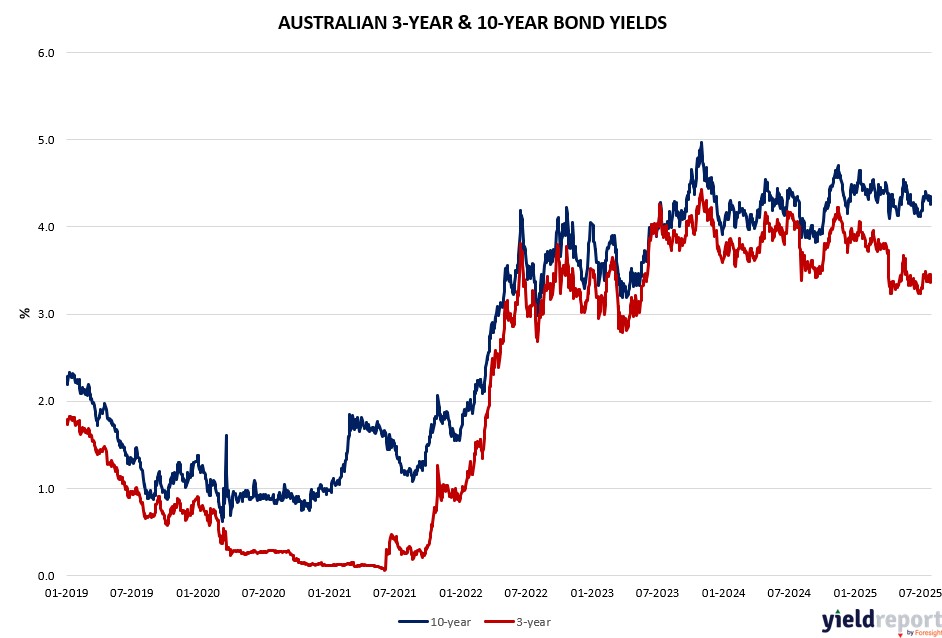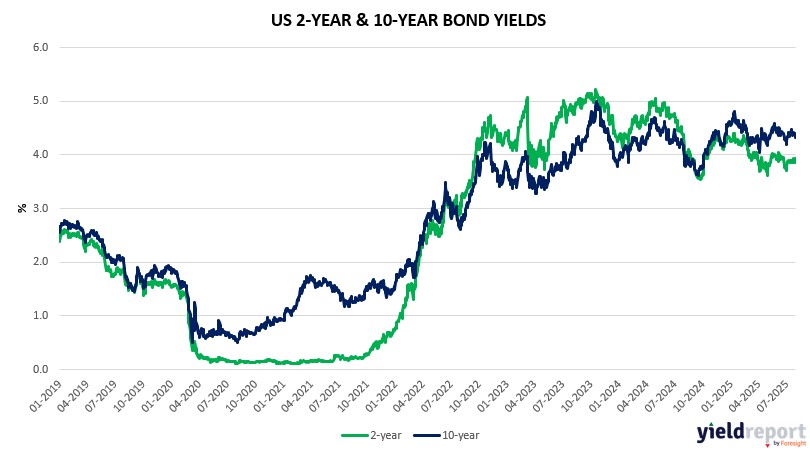| Close | Previous Close | Change | |
|---|---|---|---|
| Australian 3-year bond (%) | 3.33 | 3.434 | -0.104 |
| Australian 10-year bond (%) | 4.268 | 4.321 | -0.053 |
| Australian 30-year bond (%) | 5.027 | 5.027 | 0 |
| United States 2-year bond (%) | 3.681 | 3.953 | -0.272 |
| United States 10-year bond (%) | 4.198 | 4.396 | -0.198 |
| United States 30-year bond (%) | 4.795 | 4.9327 | -0.1377 |
Overview of the Australian Bond Market
Australian government bond yields fell sharply on August 4, 2025, as investors sought safe havens amid global trade and economic uncertainties. The Australia 2-Year Bond Yield dropped 14 basis points to 3.25%, the 5-Year Yield fell 14 basis points to 3.57%, the 10-Year Yield declined 12 basis points to 4.19%, and the 15-Year Yield shed 10 basis points to 4.57%.
The yield decline followed Friday’s US market turmoil, sparked by a weak non-farm payrolls report (73,000 vs. 110,000 expected) and Trump’s firing of the BLS commissioner, which eroded trust in US economic data. Higher US inflation (Core PCE YY at 2.8%) raised concerns that tariffs are driving prices, potentially constraining Federal Reserve rate cuts (89.1% chance of a September cut, up from 61.9%). In Australia, strong PMI data (Services PMI at 54.1) and expectations of an RBA rate cut cushioned the bond market, with traders increasing net long positions in 2-year and 5-year tenors as a hedge against global volatility.
Trump’s tariff policies, including a 10% baseline levy and higher rates on over 60 countries, continued to stoke inflationary fears, though Australia’s exemption provided some relief. The Australian Treasury is expected to maintain stable auction sizes for August-October, signaling confidence in debt issuance. Strategists from HSBC and Morgan Stanley suggest bond yields could stabilize if the RBA cuts rates as expected, but persistent US trade disruptions may keep longer-dated yields under pressure.

Overview of the US Bond Market
Action in the bond market was fairly muted as the US is set to auction $125 billion of new three-, 10- and 30-year debt this week. The dollar was little changed. Oil fell as traders took stock of OPEC+’s latest bumper supply increase while Donald Trump vowed to penalize India for buying Russian crude.
Treasury yields extend the decline triggered by Friday’s disappointing jobs report, after June factory orders contract by 4.8%.
Odds of an interest rate cut by the Fed in September are priced at 90% on the CME’s FedWatch tool. Economists surveyed by WSJ expect the U.S. trade deficit to shrink in June, in data due tomorrow. July services PMI is expected to move up.
The 10-year yield fell 0.021 percentage point to 4.197% and the two-year declined 0.022 p.p. to 3.680%, in both cases the lowest yield since April 30.
President Trump is expected to place an ally at the top of the agency in charge of measuring employment, after firing the BLS commissioner following below-forecast job creation in July and sharp downward revisions in May and June. Markets are pricing in 86% odds of a Fed cut in September, up from 63% a week ago, CME data show. June factory orders are expected to contract, in a WSJ survey.
The effective yield on AA‑rated U.S. corporate bonds stood around 4.77% on August 4 near multi‑month highs and well above the long‑term average of 4.15%.
High‑yield bond spreads remained compressed, signaling investor confidence reminiscent of early‑2021 risk appetite.


